Remainder Calculator
- Regular Polygon Calculator
- Reducing Fractions Calculator
- Rectangular Prism Calculator
- Rectangle Calculator
Remainder Calculator with Steps
Quickly find the remainder of division operations with our Remainder Calculator! Dive into modular arithmetic with ease and understand the basics of remainders. Simplify your mathematical calculations today!
Table of Contents
Remainder Calculator
Welcome to our Remainder Calculator guide! Remainders are fundamental in modular arithmetic and division operations. In this article, we’ll explore the concept of remainders, their significance, and demonstrate how to use our specialized calculator for accurate and efficient calculations.
Remainder Calculator Overview
What is Remainders?
A remainder is the amount left over after performing a division operation. In mathematical terms, when you divide one number by another, the remainder is the number that is left when one number cannot be divided evenly by another.
Significance of Remainders
Remainders play a crucial role in various mathematical concepts and real-world applications, such as:
- Cryptography: Encrypting and decrypting messages using modular arithmetic.
- Computer Science: Addressing memory locations and handling overflow operations.
- Finance: Calculating interest, dividends, and financial transactions involving division.
- Engineering: Designing algorithms, systems, and protocols with modular arithmetic.
How the Calculator Works
Our Remainder Calculator simplifies the process of calculating remainders for division operations. Simply input the dividend and divisor, and the calculator will provide the quotient, remainder, and step-by-step explanations.
A Remainder Calculator is a tool that calculates the remainder of a division operation between two numbers. The remainder is the amount left over after dividing one number by another, and it is represented by the symbol “%”.
How to Use the Remainder Calculator
- Input the dividend (the number to be divided) and the divisor (the number to divide by).
- Click on the “Calculate” button to perform the division and obtain the remainder.
Calculator:
Division Inputs:
- Dividend: [__________]
- Divisor: [__________]
[Calculate]
Example:
Let’s say we want to find the remainder when 17 is divided by 5.
Input Dividend as 17 and Divisor as 5.
Click “Calculate.”
The calculator will perform the division and display the quotient as well as the remainder. In this case, the quotient is 3 with a remainder of 2.
Step-by-Step Guide to Using the Remainder Calculator
- Enter Dividend and Divisor: Input the dividend and divisor in the designated fields.
- Initiate Calculation: Click the “Calculate” button to perform the division and determine the quotient and remainder.
- Review Result: Examine the calculated quotient, remainder, and detailed explanations displayed by the calculator.
Practical Applications
Understanding and calculating remainders has practical applications in various real-world scenarios, such as:
- Manufacturing: Distributing products, materials, and resources in production processes.
- Logistics: Optimizing routes, schedules, and delivery operations.
- Education: Solving mathematical problems, quizzes, and assignments involving division.
- Sports: Analyzing scores, statistics, and performance metrics in games and competitions.
Advantages of Using the Remainder Calculator
- Accuracy: Provides precise calculations based on mathematical principles and algorithms.
- Efficiency: Saves time and effort by automating the division process and providing detailed explanations.
- Versatility: Supports various dividend and divisor values, accommodating different numerical ranges and requirements.
How to calculate Remainder
Calculating the remainder in division involves finding the amount left over after dividing one number by another. There are a few methods you can use to calculate the remainder:
Using the Modulo Operator:
The most common and straightforward method to calculate the remainder is by using the modulo operator %. The modulo operator returns the remainder of a division operation.
Formula: Remainder=Dividend%DivisorRemainder=Dividend%Divisor
Example:
Let’s say you want to find the remainder when 17 is divided by 5.
Calculation: Remainder=17%5Remainder=17%5
Result: Remainder=2Remainder=2
Manual Calculation:
Another method to calculate the remainder manually is by performing the division and then subtracting the product of the quotient and divisor from the dividend.
Formula: Remainder=Dividend−(Quotient×Divisor)Remainder=Dividend−(Quotient×Divisor)
Example:
Using the same example, dividing 17 by 5 gives a quotient of 3.
Calculation: Remainder=17−(3×5)Remainder=17−(3×5)
Result: Remainder=17−15=2Remainder=17−15=2
Using Floor Division:
Floor division is another method where you divide two numbers and take the floor (or integer part) of the result. Then, you multiply the divisor by this integer part and subtract it from the dividend to get the remainder.
Formula: Remainder=Dividend−(Divisor×Floor(Dividend/Divisor))Remainder=Dividend−(Divisor×Floor(Dividend/Divisor))
Example:
Again, let’s find the remainder when 17 is divided by 5.
Calculation: Remainder=17−(5×Floor(17/5))Remainder=17−(5×Floor(17/5)) Remainder=17−(5×3)Remainder=17−(5×3)
Result: Remainder=17−15=2Remainder=17−15=2
These are the main methods to calculate the remainder in division. You can choose any method that you find most convenient or suitable for your specific situation.
FAQs
Q: What is a remainder in division?
A: A remainder is the amount left over after performing a division operation, representing the part that cannot be divided evenly.
Q: How do I calculate the remainder?
A: The remainder can be calculated using the modulo operation or by subtracting the product of the quotient and divisor from the dividend.
Q: Why are remainders important in modular arithmetic?
A: Remainders are fundamental in modular arithmetic for understanding cyclic patterns, encryption algorithms, and addressing systems.
Q: Can the calculator handle negative numbers?
A: Yes, the calculator supports negative numbers and provides accurate remainders for both positive and negative dividend and divisor values.
Q: Is there a limit to the size of numbers the calculator can handle?
A: The calculator can handle a wide range of numerical values, but extremely large numbers may require additional computational resources and time.
Conclusion
In conclusion, our Remainder Calculator offers a user-friendly and efficient tool for calculating remainders and performing division operations. By following the steps outlined in this guide and utilizing the calculator’s features, you can enhance your understanding of remainders, explore modular arithmetic, and apply this knowledge to various mathematical, scientific, and practical problems.

